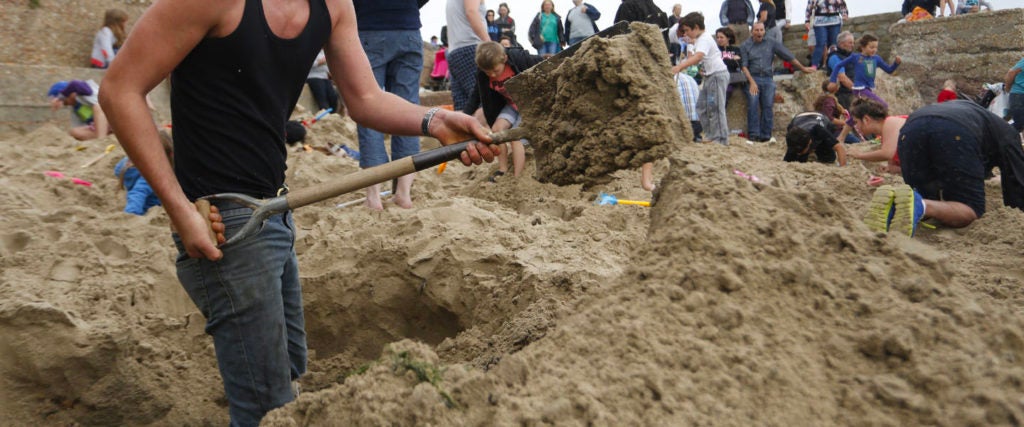Many are the tales of men who wished to conquer the greatest heights and farthest reaches of this world. The tallest mountains, the freezing poles, the tiny islands in gigantic oceans. Now our gaze is turned to the moon, Mars and the unexplored vastness of space. Men push ever outward, upward. But there is also an opposite instinct that compels us: the drive to burrow in. A thirst for digging.
The allure of the very deep hole.

There are practical reasons for such excavation, of course. Humanity has unearthed precious materials by mining, as well as a fossil record of evolutionary change and the remnants of our own earliest civilizations. We have found treasure and natural wonders.
Meanwhile, we have also dug innumerable holes for the sake of the holes themselves — or maybe the pleasure of penetration. Give some boys at the beach a couple of shovels, and they will go as deep as they can. They will continue until any occupant of the hole needs help climbing out of it. And they will discover nothing in there, except that the only limit of this cavity is their own exhaustion.

Shoreline presents an ideal setting for this endeavor, not just because sand is the right consistency for a good, steady dig and free of troublesome obstacles like tree roots, but because a relaxing vista makes men restless. Once they’ve gone swimming and thrown a football around for a bit, they yearn for something else to do. These hours of leisure are unproductive. It is incumbent upon them to alter the land — to leave their mark. A hole, though temporary, will outlast their presence, and it will alert the men of tomorrow that other men were here before. It is less a warning than a friendly challenge: see if you can make a hole this big.

Hole competition has even played out on a global scale. During the Cold War, the superpowers had a drilling race, and over 20 years, engineers in the Soviet Union pierced more than 40,000 feet, or around 7.5 miles, into the Earth’s crust before the project was abandoned. This year, Japanese researchers set a record for the deepest hole bored into the ocean floor. Scientists continue to dream of drilling all the way to the living mantle of our planet.
Are we learning anything from these expeditions? I’m sure. But the takeaway remains: Whoa, deep hole.
The Kola Superdeep Borehole in #Russia is the deepest hole in the world. It goes 12km into the ground! That's deeper than the Mariana Trench! Source: https://t.co/3SbnoZIfCX pic.twitter.com/rpz4dNU4kZ
— Simon Kuestenmacher (@simongerman600) July 11, 2018
The deepest hole ever drilled, the Kola Superdeep Borehole, is 7.5 miles (12 km) deep. Yet this is a mere 0.18% of Earth's radius. If Earth were an apple, we wouldn't have even broken the skin. pic.twitter.com/wuyTVwPd9c
— Andrew Rader (@marsrader) June 5, 2018
What drives this quest? Why are we tunneling to a core that we cannot reach? Well, it passes the time, that much is true. This might partially explain the Italian phenomenon of the umarell, a man of retirement age who watches the activity at construction sites, offering unsolicited advice to the laborers. As builders begin clearing the space for a foundation, umarells are often overseeing (and trying to supervise) how a massive hole is dug. It’s as if men no longer fit to shovel dirt still desire that satisfaction. The holes continue to fill a hole in their hearts.
Word of the day: Umarell (Italian): “Men of retirement age who pass the time watching construction sites, often with hands clasped behind their backs, offering unwanted advice.” pic.twitter.com/Zsp37ert7R
— simon armstrong (@SimonTheBookman) January 13, 2021
Best of all, a hole is never really finished. It is always a work in progress, and when we do dust off our hands to look at what we’ve accomplished, it is with the knowledge that we can yet improve upon it. Perhaps all the pointless digging is a metaphor: Men, afraid to reveal their innermost selves, would rather expose what lies beneath their feet. Regardless, the hole promises a future of progress with common cause. When we’re in the hole-zone, we break ground as brothers.
See you down there, my friends.


